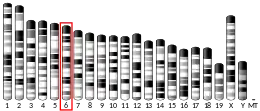KLF14
Krüppel-like factor 14, also known as basic transcription element-binding protein 5 (BTEB5) is a protein that in humans is encoded by the KLF14 gene.[5] The corresponding Klf14 mouse gene is known as Sp6.[6]
| KLF14 | |||||||||||||||||||||||||||||||||||||||||||||||||||
|---|---|---|---|---|---|---|---|---|---|---|---|---|---|---|---|---|---|---|---|---|---|---|---|---|---|---|---|---|---|---|---|---|---|---|---|---|---|---|---|---|---|---|---|---|---|---|---|---|---|---|---|
| Identifiers | |||||||||||||||||||||||||||||||||||||||||||||||||||
| Aliases | KLF14, BTEB5, Kruppel-like factor 14, Kruppel like factor 14 | ||||||||||||||||||||||||||||||||||||||||||||||||||
| External IDs | OMIM: 609393 MGI: 3577024 HomoloGene: 76469 GeneCards: KLF14 | ||||||||||||||||||||||||||||||||||||||||||||||||||
| |||||||||||||||||||||||||||||||||||||||||||||||||||
| |||||||||||||||||||||||||||||||||||||||||||||||||||
| |||||||||||||||||||||||||||||||||||||||||||||||||||
| |||||||||||||||||||||||||||||||||||||||||||||||||||
| |||||||||||||||||||||||||||||||||||||||||||||||||||
| Wikidata | |||||||||||||||||||||||||||||||||||||||||||||||||||
| |||||||||||||||||||||||||||||||||||||||||||||||||||
Function
KLF14 is a member of the Krüppel-like factor family of transcription factors. It regulates the transcription of various genes, including TGFβRII (the type II receptor for TGFβ).[7] KLF14 is expressed in many tissues,[8] lacks introns, and is subject to parent-specific expression.[9]
KLF14 appears to be a master regulator of gene expression in adipose tissue.[10]
Protein structure
Like the other members of the KLF family, KLF14 has three zinc-finger domains near the C-terminus, all three of which are of the classical C2H2 type. In the human, they are at amino acids 195–219, 225–249, and 255–277.[11]
Human KLF14 is 323 amino acids in length, with a molecular weight of 33,124;[11] in the mouse its length is 325.[12]
Clinical significance
There appears to be a connection between KLF14 and coronary artery disease, hypercholesterolemia and type 2 diabetes.[13][14]
References
- GRCh38: Ensembl release 89: ENSG00000266265 - Ensembl, May 2017
- GRCm38: Ensembl release 89: ENSMUSG00000073209 - Ensembl, May 2017
- "Human PubMed Reference:". National Center for Biotechnology Information, U.S. National Library of Medicine.
- "Mouse PubMed Reference:". National Center for Biotechnology Information, U.S. National Library of Medicine.
- "Klf14 Kruppel-like factor 14 [Mus musculus] - Gene result".
- "Sp6 trans-acting transcription factor 6 [Mus musculus] - Gene result".
- Truty MJ, Lomberk G, Fernandez-Zapico ME, Urrutia R (Mar 2009). "Silencing of the transforming growth factor-beta (TGFbeta) receptor II by Kruppel-like factor 14 underscores the importance of a negative feedback mechanism in TGFbeta signaling". The Journal of Biological Chemistry. 284 (10): 6291–300. doi:10.1074/jbc.M807791200. PMC 2649086. PMID 19088080.
- Swamynathan SK (Apr 2010). "Krüppel-like factors: three fingers in control". Human Genomics. 4 (4): 263–70. doi:10.1186/1479-7364-4-4-263. PMC 2975451. PMID 20511139.
- Parker-Katiraee L, Carson AR, Yamada T, Arnaud P, Feil R, Abu-Amero SN, Moore GE, Kaneda M, Perry GH, Stone AC, Lee C, Meguro-Horike M, Sasaki H, Kobayashi K, Nakabayashi K, Scherer SW (May 2007). "Identification of the imprinted KLF14 transcription factor undergoing human-specific accelerated evolution". PLOS Genetics. 3 (5): e65. doi:10.1371/journal.pgen.0030065. PMC 1865561. PMID 17480121.
- Small KS, Hedman AK, Grundberg E, Nica AC, Thorleifsson G, Kong A, Thorsteindottir U, Shin SY, Richards HB, Soranzo N, Ahmadi KR, Lindgren CM, Stefansson K, Dermitzakis ET, Deloukas P, Spector TD, McCarthy MI (Jun 2011). "Identification of an imprinted master trans regulator at the KLF14 locus related to multiple metabolic phenotypes". Nature Genetics. 43 (6): 561–4. doi:10.1038/ng.833. PMC 3192952. PMID 21572415.
- "Krüppel-like factor 14". Human Protein Reference Database. Johns Hopkins University. Retrieved 2011-05-18.
- Online Mendelian Inheritance in Man (OMIM): Krüppel-like factor 14 - 609393
- Voight BF, Scott LJ, Steinthorsdottir V, Morris AP, Dina C, Welch RP, et al. (Jul 2010). "Twelve type 2 diabetes susceptibility loci identified through large-scale association analysis". Nature Genetics. 42 (7): 579–89. doi:10.1038/ng.609. PMC 3080658. PMID 20581827.
- Grarup N, Sparsø T, Hansen T (Dec 2010). "Physiologic characterization of type 2 diabetes-related loci". Current Diabetes Reports. 10 (6): 485–97. doi:10.1007/s11892-010-0154-y. PMC 2955912. PMID 20886378.



